You can finally buy a virtual reality headset and use it in your home. Right now -- today -- that is possible. It doesn't cost $10,000 and it doesn't come with caveats like, "This is made for developers." Samsung is officially the first to market with an accessible, impressive virtual reality headset, all powered by software from Facebook's recently acquired Oculus VR team. That alone is very exciting: We are standing at the precipice of a new medium, finally technologically possible. Wireless, consumer-grade virtual reality! In your home! Today!
Samsung's Gear VR is both an astounding feat and an illuminating vision into our near future; it's the closest anyone's come to making virtual reality into a palatable consumer experience, and a stark example of how far we still have to go before that dream is completely realized.
Gallery: Samsung Gear VR "Innovator Edition" review | 22 Photos
Engadget Score
Pros
- Incredibly accessible
- Light, comfortable, attractive
- Extremely impressive visuals
Cons
- Limited functionality
- Extremely limited software library
- Requires a Note 4, making it very expensive
Summary
Oculus VR and Samsung's Gear VR virtual reality headset is an enticing first taste of the potential future of a new medium. It's light, comfortable and -- most importantly -- accessible. Gear VR is the most usablevirtual reality headset we've ever tried, and the first to market after several years of hype. At the same time, an extremely limited selection of software and functionality makes Gear VR live up to its "Innovator Edition" alias: It's a device intended for early adopters and virtual reality enthusiasts, not the mainstream. At least for now.
If you're looking for guidance on whether or not you should buy a $200 Gear VR headset to strap your $700 Galaxy Note 4 into, this isn't the review for you. Frankly, it's a lot to pay for the experience, and I don't feel comfortable suggesting anyone shell out that kind of cash for Gear VR. And let's be honest: The folks who would drop that kind of money for the promise of Gear VR are crazy people like me. They've already bought one.
Samsung intentionally dubbed Gear VR's first iteration the "Innovator Edition." There's good reason for that: It's more tech demo than consumer product right now. Save for a few games, the app store consists of just over a dozen "experiences"; every other "game" is a demo at this point. To be clear up front, Gear VR is not intended as a mainstream consumer device; it's a test balloon from one of the world's largest electronics manufacturers. Here's what Nick DiCarlo, VP/GM of immersive products and VR at Samsung, told me last week about his company's goal with Gear VR:
"The gauge of success is about did people who bought it like it and did they not return 100 percent of them. It's as simple as that. If someone bought it and liked it and told their friends about it and thought it was cool? Awesome! If we get it back and everyone's like, 'This doesn't work well; I don't like it; it's horrible.' Then we know we've got a lot more room to improve than we thought. We think that we've hit the formula, but the idea is that we're able to move VR forward -- 'existence-proof,' to steal a word from John Carmack. VR exists! Thank goodness it finally exists! We think people are gonna really, really like it, but we know that there's a lot of room to continue to make it better and we will do that."
It's not being sold at your local Best Buy, and for good reason.
Samsung intentionally didn't send out review units to press before Gear VR went on sale; the point wasn't to bury reviews, but to discourage them altogether. The idea is that the people who buy this early will evangelize it to their friends, helping to build a virtual reality market that companies like Samsung can profit from. There are Gear VR setups in malls all over the world. It's meant to be a demonstrative device. That it's on sale is just the easiest way for Samsung to distribute it to evangelists. But it is on sale to the public.
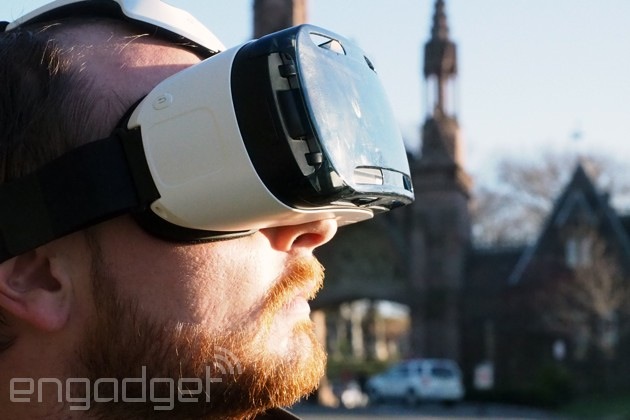
With that in mind, I'm taking a dual approach to this review: one perspective for the VR enthusiast, and another for the average human being.
Getting acquainted with virtual reality through Gear VR
For the average human being
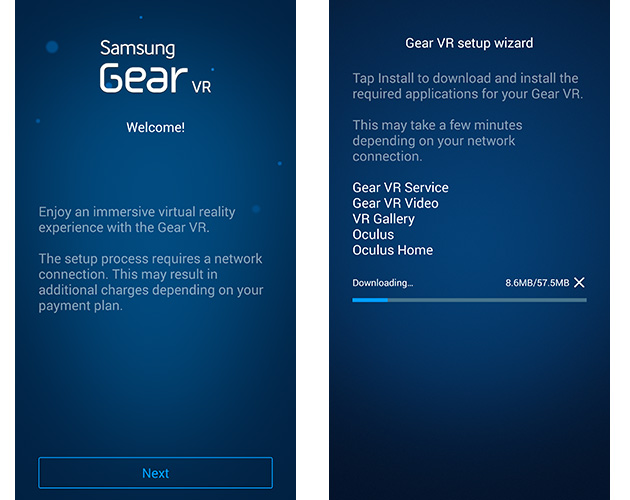
First, you must own a Samsung Galaxy Note 4 smartphone. Second, you must make sure it's up to date with the latest firmware from your carrier. Third, you must insert the 16GB microSD card that comes with Gear VR into your phone. The phone both powers VR experiences and acts as the Gear VR's screen. There's no real "setup" required; after you've removed the miles of plastic protection stuck to various regions of the headset, you simply attach your Note 4 to the front of the shell. After removing the slightly darkened front plastic casing, you'll see a docking area for the phone. On the left side of the front is a micro-USB plug where you carefully dock your Note 4, screen facing inward; on the right side, there's a latch on a flexible-yet-sturdy rocker for securing the phone to the headset. It's not perfectly slick, but it works significantly better than any other VR setup I've been through.
Once docked, an audible jingle plays through the phone's built-in speaker to let you know the headset is ready for use. After you've adjusted the headset to your liking, the first instructions are to remove the phone and go through the software install process. It's thankfully quick: You're downloading the basics, from the operating system ("Oculus Home") to the video player ("Gear VR Video"). After that's complete, you're basically ready to go -- slap the headset on your head with the phone attached and adjust the Velcro straps to your comfort. When you put it on your face, the sensor built into the headset's interior detects that you're close and starts loading into the main menu. That's it! You're in!
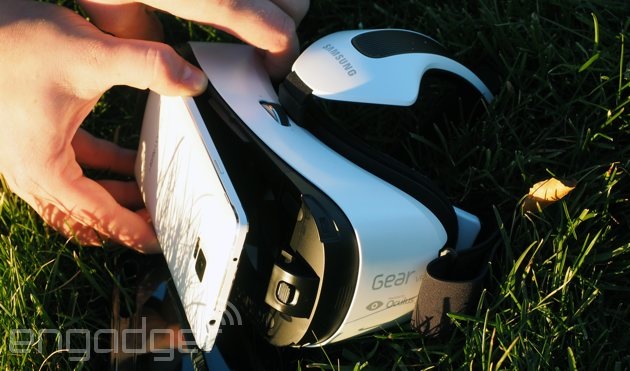
If you want to run through a quick tutorial of how to use the headset, Samsung has one ready for you. The long and short is this: Swiping on the touchpad (located on the right side of the headset, where your temple would be) advances forward to the next menu; tapping on the touchpad selects whatever you're looking at (it's used for pausing movies and in-game actions, among other things); a single "back" button (ridged for quick location) rests above the touchpad and can be pushed (to go back or to cancel) or held (to reach a sub-menu from within games/apps). There's a volume rocker in front of that. Congratulations: You know the full scope of operating Gear VR. Seriously!
Should you choose to pair a Bluetooth controller to your Note 4 (either before connecting the headset or during use), the main Oculus Home area can be navigated using the controller's left analog stick. That said, it's a lotmore fun pointing your head at stuff and tapping the touchpad, like some sort of wizard.
Does the setup process seem a bit convoluted as a result of having to attach and detach your phone to the headset a few times? Sure. Is it difficult or confusing? Nope! In fact, it's far easier than setting up the Note 4 itself -- far fewer menus to click through and less nonsense to deal with. Whether it was Oculus, Samsung or some mix of both that was responsible, Gear VR is thankfully streamlined from the start to get users acquainted with VR as soon as humanly possible. If it feels bare-bones, that's assuredly intentional -- the goal here is accessibility.
For the VR enthusiast
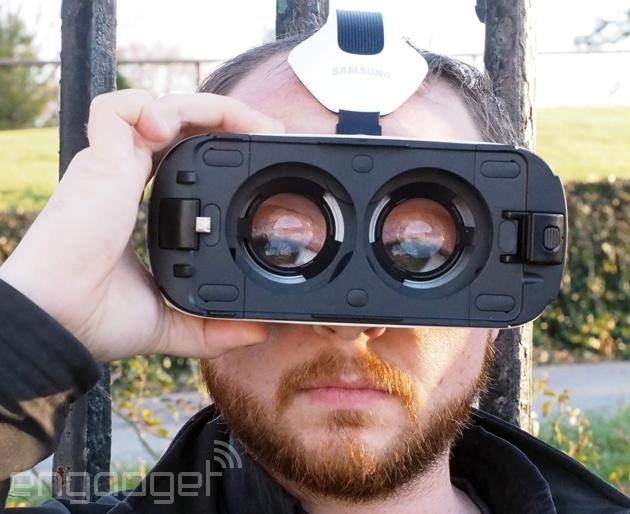
There's never been an easier setup in the (very short) recent history of virtual reality headsets. Provided that your Note 4 firmware is up to date, it's a matter of slapping the headset into the holder on the front and following instructions (detailed above). Gear VR is not a dev kit and you don't have to spend a bunch of time updating firmware, calibrating cameras and testing resolution settings. In my experience -- which included updating the firmware on the Note 4 -- setup took around 15 minutes, including time to download/install firmware (which required a hardware restart) and also the headset's software suite.
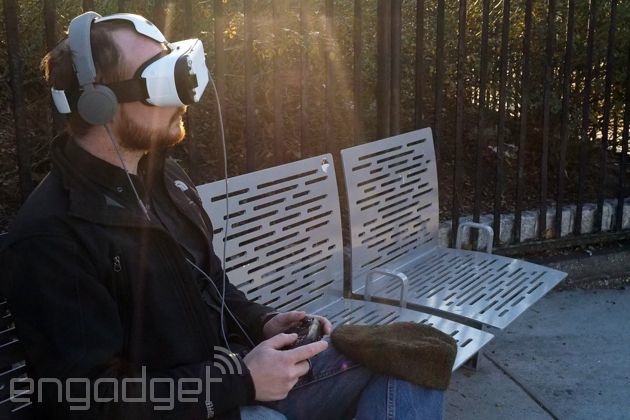
Maybe you want to use a Bluetooth gamepad, which some games require? Just pair it with your Note 4 and you're good to go. Perhaps you want to wear headphones while using Gear VR, for the Maximum Immersion Experience™ (seen above)? Just plug in your cans to the exposed one-eighth-inch audio jack. And yes, you can leave the translucent plastic cover off the front of your Gear VR pretty much permanently -- it's solely an aesthetic choice and, if anything, kinda gets in the way. It does make the headset prettier while in use, but are you really that concerned about your looks while wearing a VR headset? No one is immune to (what I'm calling) Headset Hair.
Life in virtual reality
For the average human being
Like smartwatches, virtual reality headsets don't have enough functionality to outright replace other electronics usage -- especially your smartphone. You can't answer a phone call, text message or email while wearing Gear VR, though you can see them pop up in your peripheral vision. It's an incredible tease: A green phone icon appears, which expands with more information about the caller when you look at it. The only options as of now are to end the call with a tap on the touchpad or outright remove your phone from the headset to answer the call.
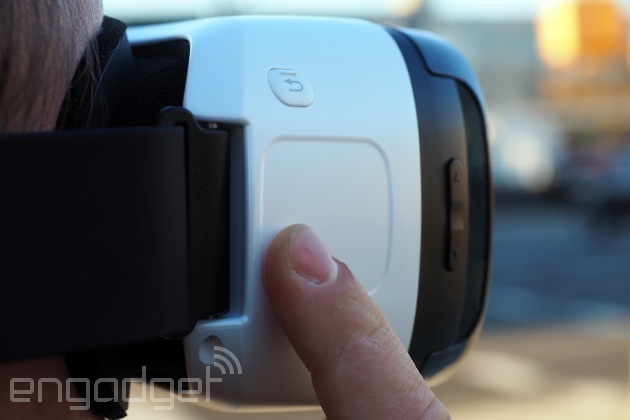
I'd be incredibly impressed if you're able to remove the phone in time to answer phone calls without accidentally hanging up on the caller in the process. It's simply not a realistic option, and it's the kind of rough edge that explains the "Innovator Edition" name. In this respect, Gear VR doesn't necessarily slide right into your life. It's still a device that requires dedicated use, like a game console or a camera; it's not viable to use as a replacement device just yet.
The foundations of that functionality are in place; that you can see rich information about phone calls, text messages and emails ("notifications") is a great start. It's a taste of a future where you casually pause whatever you're doing in VR -- from walking around virtual Rome to watching House of Cards in a virtual 4K movie theater -- to take a phone call or watch a silly YouTube link your friend sent you. Software like VR Gallery and Oculus Cinema lay the groundwork for a future where your vacation photos exist in an ornate virtual gallery space, and where family movies are viewed in a theater setting. It's impossible to convey how much joy it brought me to watch a silly 10-second video I shot of my cat with the Note 4 -- I went from shooting a video with my phone to watching it in a massive virtual theater (pictured below) in less than one minute. Little touches like that offer an amuse-bouche to the feast of virtual reality experiences to come.

I cannot be clear enough here: VR will live and die by its ability to integrate into normal life. It will remain a novelty if it is solely focused on immersion -- the ever-marketable "presence" -- rather than enabling new ways to interact with the things we all already know and love. Things like home movies and photos are a huge part of the reason for the explosion of the smartphone. VR is more than capable of taking that stuff a step further, and Gear VR is indeed a big push forward, but it's not all there yet.
In the short run, new experiences like Oculus 360 Photos and Oculus 360 Videos -- especially the latter -- are incredibly enticing. You might think that being able to look around a photo in every direction isn't that exciting -- I challenge you to try it and remain unimpressed. That impact is multiplied greatly when using the 360 video player: There's a tour of Iceland from the foot of a helicopter that is both gorgeous and incredibly intense. Look in any direction, as if it was real life, and you've got an incredible view.
The promise of virtual tourism is tremendous; the feeling of awe you experience when looking down from a cliff face or squaring up to a massive waterfall is truly extraordinary. You can almost taste the moisture in the air, feel the cold breeze as you fly below the clouds attached to a heli. It's an overwhelming sensory experience. Samsung offers a taste of that experience when you first put on Gear VR, as seen below in the intro video.
{C}{C}
For some people, that experience might outright cause motion sickness. I was fine, but some colleagues I put into the headset -- specifically with 360 video viewing -- felt nauseous. "Your mileage may vary" is the cliché nonsense to say here, and it's sadly accurate: Different people respond differently to virtual reality, and some folks are far more sensitive to the motion sickness effect. If you're feeling sick while using Gear VR (or any VR headset), the solution is thankfully simple: Remove the headset and chill out for a second.
For the VR enthusiast
Good news, VR enthusiast: Everything is free on the Gear VR app store and downloading/installing/maintaining software is as easy as it is on your smartphone. There's a paid store coming in "early 2015," but for now, there are just over a dozen things to download for use with Gear VR. A handful are "experiences," both interactive and not: a snippet from Cirque du Soleil, a Pacific Rim jaeger pilot demo and an Avengers... thing are all highlights. The other content is mostly game demos, with a few full games to offer a taste of the upcoming storefront (head below for more detail on individual games).
Jumping in and out of software on Gear VR isn't quite as easy as it is on your phone, or even your game console. If you start an app in Gear VR, you're in it until you close it. There's only a bare minimum of multitasking available, such as the aforementioned notification pop-ups. You're not going to quickly jump from one app to another and then back again without starting each app from scratch each time. Thankfully, software opens quickly and I rarely found myself sitting around waiting for an app to load.
This will assuredly become a bigger problem as virtual reality headsets do a better job of integrating into normal life -- it's gonna be a big problem if, say, Netflix has to be fully restarted each time you want to quickly look at Twitter. That's a scenario we're likely to see sooner than later, as even the first iteration of the Oculus Cinema app makes it clear that consuming media is going to be a major use case for VR headsets.
Lying on my back, watching a movie in a virtual cinema is an incredible experience, and one that I'm confident other folks will also dig. It's a dramatically better experience than watching video on your phone. Here's famed movie director and Twin Peaks co-creator David Lynch reminding us how good that experience is:
And he's right! I think Lynch would agree, though, that Oculus Cinema (to say nothing of 360 video viewing) is a dramatic improvement over watching video on a phone. Hell, it's an improvement over watching video on your home TV -- unless you've got a home cinema? Maybe you do, fancy pants! I don't, and neither do most people. This functionality alone has me anxiously anticipating YouTube, Netflix, Hulu and other video apps.
UI, battery life and passthrough
Like most aspects of Gear VR, the operating system is relatively skeletal. There's the "store," which looks the same as the "library." There's the "home" screen, which is very similar looking to the other two. And that's really it. Here's a mockup of the Store screen from Oculus:

In actuality, the Store screen isn't on a slant; none of the games above are available; and there's a lot less unused space. There's no way to take screengrabs within Gear VR, and Oculus/Samsung aren't providing images, so, uh, the best we've got is words and the mockup seen above. It's not an ideal situation. Regardless, the general layout isn't far off, and the option to switch between Samsung-curated and Oculus-curated apps is the only filter within the Store page.
The Library is identical, except you can filter among installed apps, all available/purchased apps and an updates section. In both the Store and the Library, each app has its own page with options for more info, images of the app, potentially video of it in action and an updates section. It looks and acts a lot like any app page you've encountered on your phone or game console or wherever else, with one exception: There's a "comfort" rating. It ranges from comfortable "for most" to comfortable "for few" -- yet another nod to the early nature of Gear VR.
Like a game console, the Home screen has your most recently used apps: Six applications are arranged in the center area, with links to the store on the left and your library of software on the right. Selecting anything is as simple as looking at it and tapping the touchpad.
You can't rearrange the locations of various apps, nor can you resize them or "pin" any to the home screen. There's no way to change the background or really customize the UI in any way. I'm not citing this as a limitation, but to say that the UI is extremely lightweight and focused. Again, it's clear that this is the base level for consumer-grade functionality.
But wait, there's a second UI. Scandalous! Okay, not so scandalous -- it's a sub-UI that can be accessed from within running software. This is where that back button comes into play once again: Holding down the button brings up the sub-UI, which offers a handful of toggles on the fly.
Think of the sub-UI as a quick-access option for several important functions, so that you don't have to dump all the way back to the Oculus Home OS every time you want to make minor tweaks to settings (or to access the passthrough camera, which is genuinely very useful).
Maybe you'd like a sip of water? The sub-UI has a passthrough camera switch, which turns on the Note 4's rear camera and pumps the stream into the headset. You essentially see "through" the headset you've got on, albeit slightly delayed due to video latency. It's kind of like being Robocop? I'm not sure how else to describe that, as I've never seen the world through the eyes of a camera before.
Or maybe the screen is too bright? This is where you can turn it down. There's also an option to reorient the headset, and a "comfort mode" setting (which softens the screen colors).
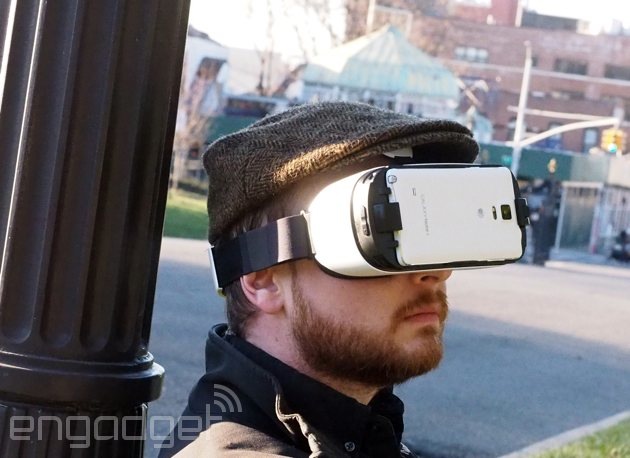
Let's talk about that passthrough camera for a second: There is no way any VR headset ships to consumers without this feature going forward. If they do, they're flawed out of the box. The passthrough camera is Gear VR's greatest contribution to modern virtual reality -- beyond wireless VR, beyond accessibility.
Oculus VR CTO and Gear VR lead John Carmack called it his "Diet Pepsi button." There's good reason for that: The passthrough camera legitimately enables you to take a sip of a drink without having to remove your VR headset. It enables you to pet your dog, or answer your husband in the other room, or the myriad other actions you might want to do without having to take off your VR headset. It genuinely alters how you interact inactual reality while wearing a virtual reality headset. It's hard to be hyperbolic here about the importance of the passthrough camera: It is precedent-setting.
Games
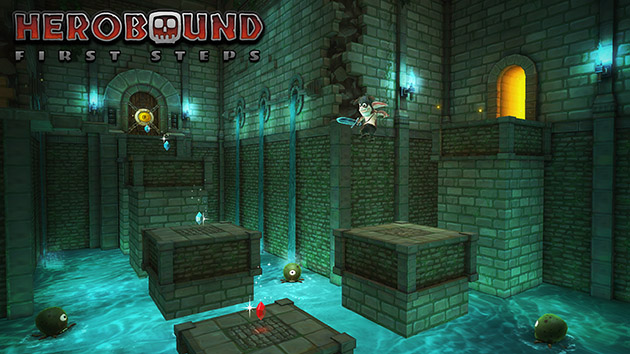
I'm not going to review every single game for Gear VR, mostly because the vast majority are demos. Moreover, literally everything is free on Gear VR's "store" right now, so, ya know, why not just download everything? You certainly won't run into file-size limitations. Seriously, you should do that. It's less than 20 apps, and many are short experiences. Let's start with the not-so-short:
- Herobound: First Steps is the first game officially released by Oculus VR. It was developed in-house, and has players guiding a small hero character from room to room, taking on everything from skeletons to ghosts. It's kind of like a prettied-up, dumbed-down, modern version of the original Legend of Zelda game for the Nintendo Entertainment System. I'm being far too generous in that comparison, but I mean that to say it's a "single screen" game; your view of the world is that of a giant, looking down into little rooms full of tiny characters. It's a fine distraction, but does little to engage the VR headset you're playing it on.
- Ikarus is a much better example of what can be done, gaming-wise, in Gear VR. In Ikarus (which is a demo), you're once again viewing the world from the bird's-eye view, and you're using vision to guide a place marker where you'll send your in-game avatar. The goal in Ikarus is to get from one side of a level to another without getting your defenseless character killed by robots. When you do complete an area, you're rewarded with a first-person cutscene as your character is whisked from one area to the next. It's beautiful and engaging and exactly the kind of unique experience I'm looking to have with mobile VR.
- Dreadhalls is one of several demos that made its way from Oculus' development kits (in the hands of indie devs) to Gear VR. It's one of the few that requires a gamepad to play (I used a Moga Pro, which worked great), and it's the only game available right now attempting to scare players. Even with muddy textures and rudimentary "monsters,"Dreadhalls is terrifying. As in "people rip the headset off while they're playing it" kind of terrifying. When a floating orb with sharp teeth comes floating directly at your face, even though you know it's not real, you react like it is. There are huge, glaring flaws with Dreadhalls: It makes people sick; it bucks the best practices of VR by assigning the headset's view to a gamepad analog stick (read: You can "look" in game by turning your head and/or by pushing an analog stick); and it doesn't work well, mechanically speaking. All of those flaws are dramatically superseded byDreadhalls' ability to scare the crap out of you far more effectively than multimillion-dollar horror films.
- Esper is my favorite game available for Gear VR. It's a puzzle game that feels thematically similar to the humor in Portal, with unnamed scientists hilariously goading you through "tests" required of people with telekinesis. Apparently humans gained the ability recently and an agency was set up to familiarize people with their newfound powers. Sure, it's a silly premise, but the humor is genuinely funny and the puzzles make great, unique use of the VR headset.
- Proton Pulse is Breakout, but in 3D and your "paddle" is controlled by where you look. It's not "like" Breakout -- it's the same game, updated for 3D and VR. That's not to say it's unoriginal and it's certainly not to say that it's not a fun game. On the contrary, Proton Pulse is excellent: a fun, fast-paced game that's perfect for a few minutes of free time. It is unfortunately buggy at the moment (it's the only game to hard crash my Note 4), but that's easily fixed by updates.

- Darknet is one of the few full games available, and it's the evolution of the winning entry in Oculus' VR Jam. It's a hacking game that looks like the way hacking is depicted in film: hilariously visual and inaccurate, but a lot more fun to look at. It's much easier to spend a lot of time inDarknet than many other games within Gear VR, mostly because it's not a "world" as much as it is a UI as a game.
There are, of course, several other games on Gear VR, none of which are outright terrible. There are no games that you shouldn't bother checking out right now, mostly because there are so few games period. Rest assured we'll have a more critical guide when the actual Gear VR store launches with paid apps in the coming months.
Wrap-up
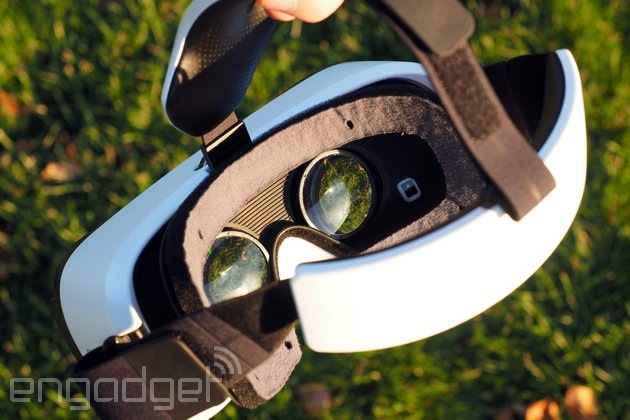
Gear VR is a device full of potential. It works! The screen resolution is almost good enough that you don't constantly think about the headset you're wearing! It's light and easy to keep on for long periods! It's not $10,000! The battery life is pretty okay (seriously, if you're burning out your Note 4 from Gear VR use, you need to take more frequent breaks)!
It's also a device still full of limitations. When you're in Gear VR, you're inGear VR -- no answering phone calls or looking at the internet or anything else you do with your phone. The list of software -- right now -- is insanely short. It only works with a single phone, and that phone is incrediblyexpensive off-contract. And it's not exactly tiny: Gear VR comes with its own carrying case that doesn't fit into any normal-sized bags. The Back to the Future 2 glasses these are not.
But should you buy it?
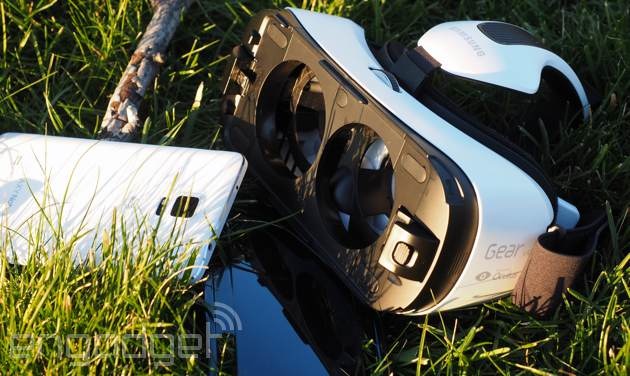
Whether or not you should buy Gear VR is difficult to answer at the moment. For those of us already drinking the Kool-Aid of virtual reality as a medium, it's by far the most impressive consumer experience and every bit worth owning. I'd even venture as far as to say it's worth owning a Note 4 so that VR enthusiasts can own Gear VR, which is saying a lot considering how much I don't like the Note 4.
But for the average consumer, Gear VR will feel half-done, or like a tech demo. It's a great jumping-off point for VR nutcases like myself to easily evangelize and demonstrate the promise of virtual reality. But Gear VR is still several steps removed from the level of polish and functionality consumers expect.
So, should you buy it? Like so many things, it depends on you. What I can say definitively is that Gear VR offers a unique, amazingly demonstrative experience of what virtual reality headsets can be. Whether or not you buy one doesn't really matter -- you must try one.
[Image credits: Joseph Volpe (photos); Oculus VR/Samsung (screenshots/video)]






Aucun commentaire:
Enregistrer un commentaire